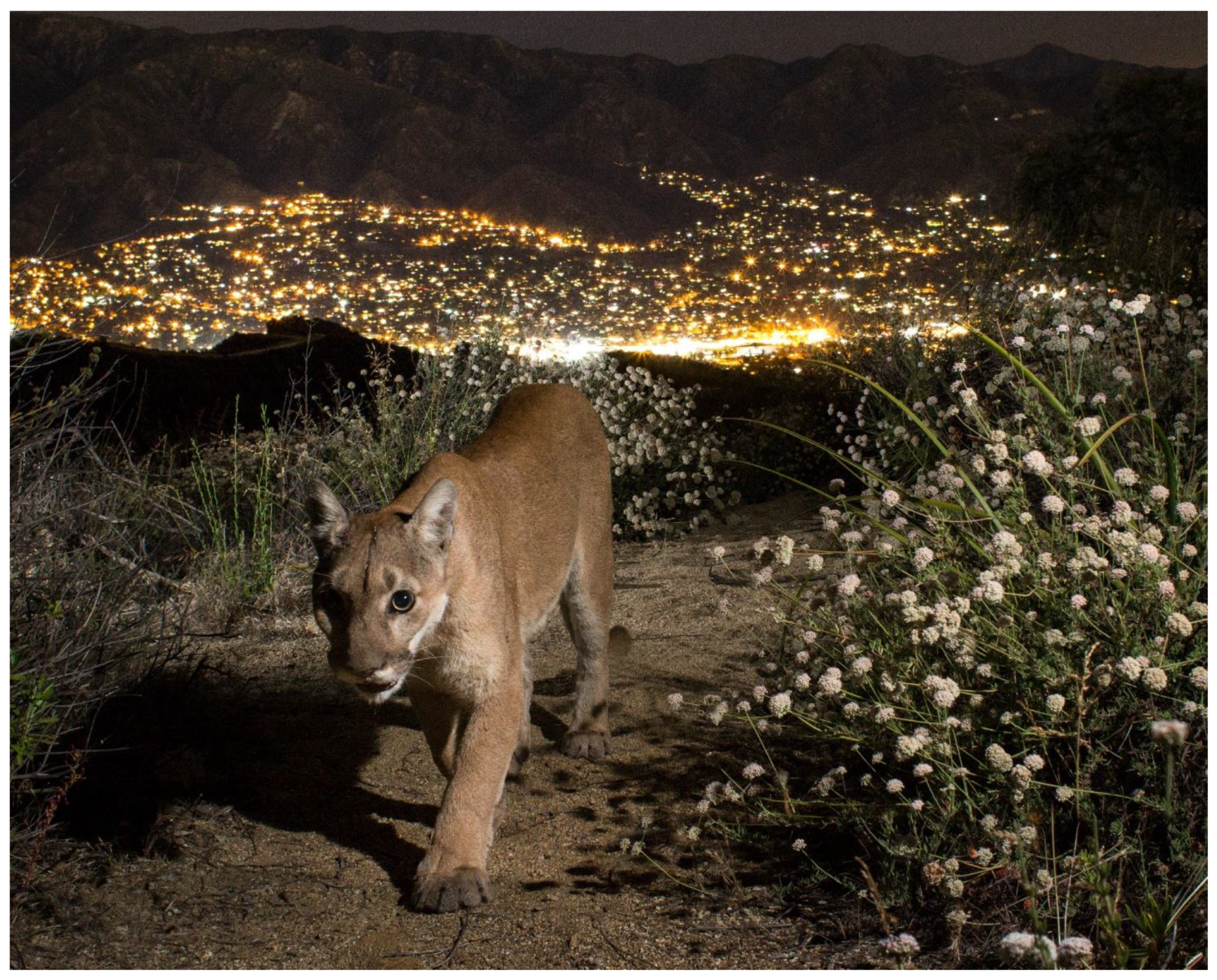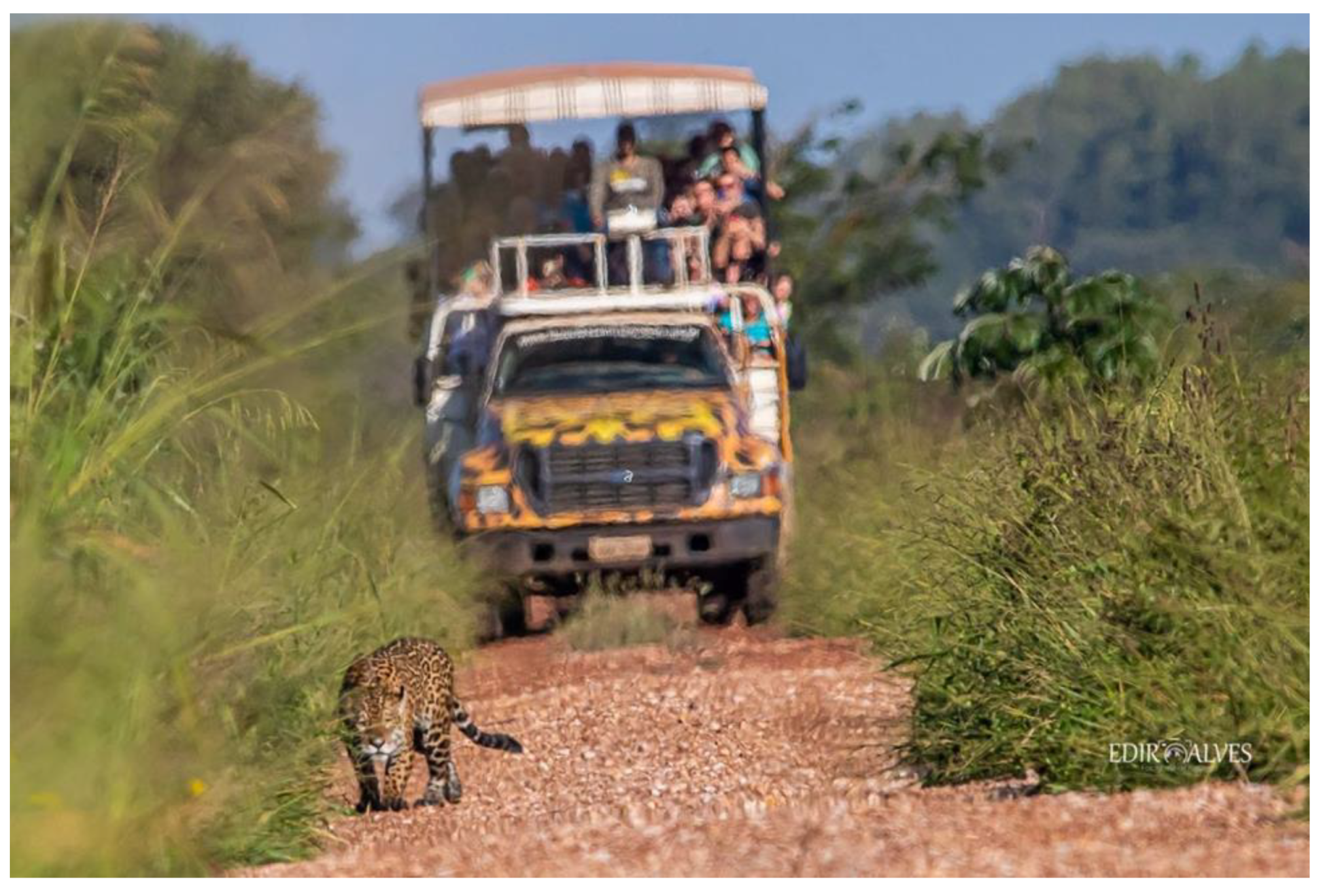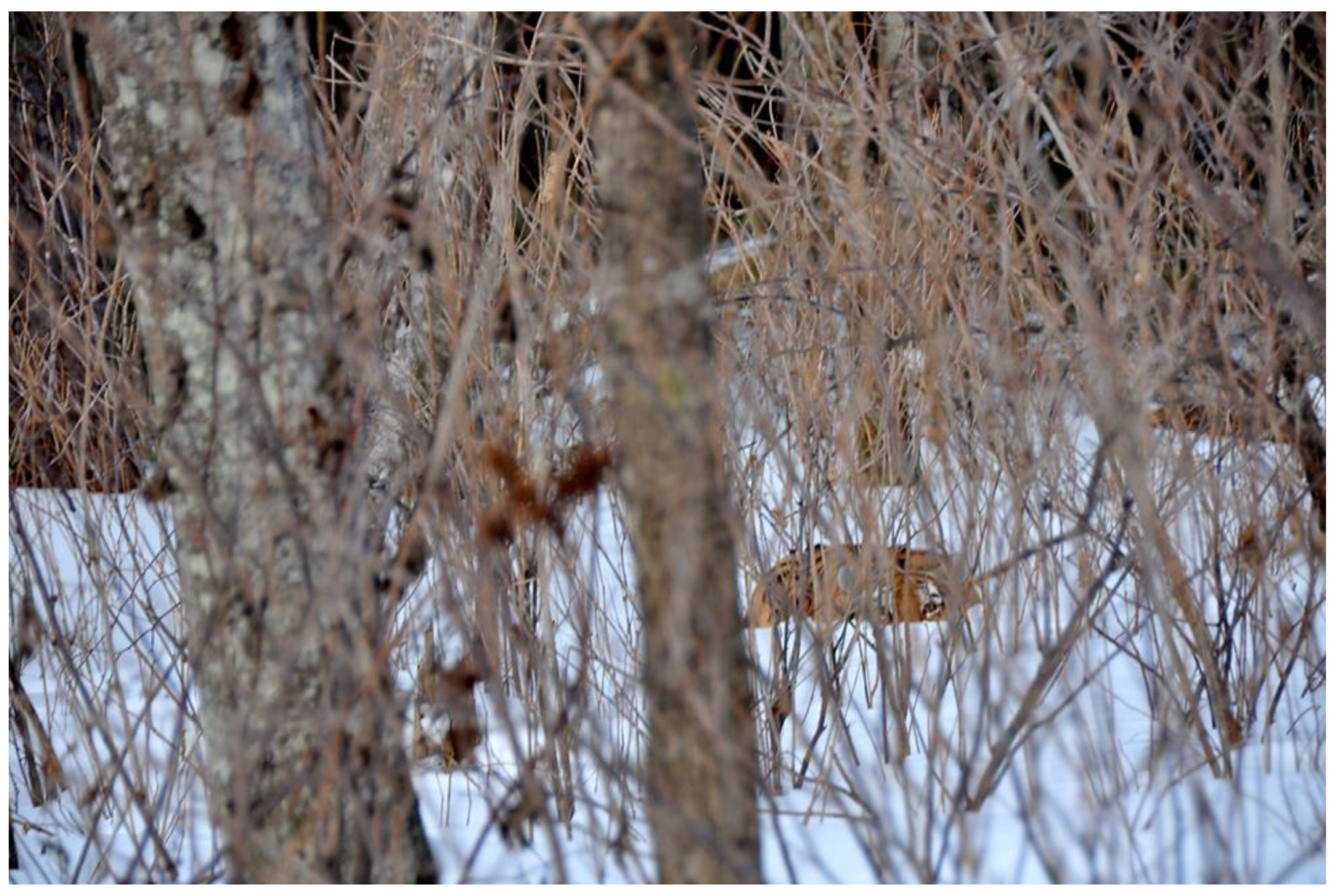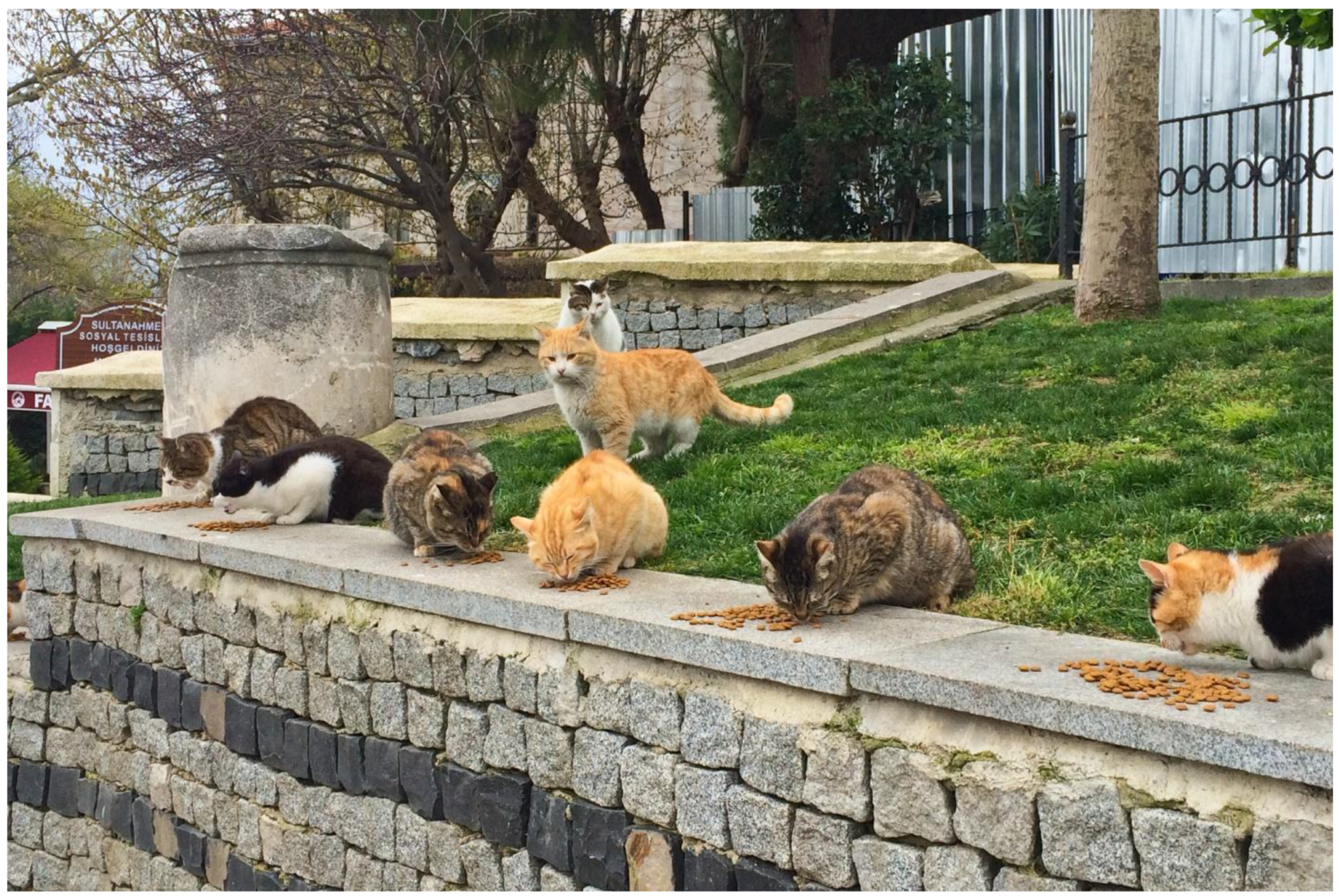Re-Thinking Felid–Human Entanglements through the Lenses of Compassionate Conservation and Multispecies Studies
Abstract
Simple Summary
Abstract
1. Introduction
2. Setting the Scene: Positive Felid–Human Cohabitation and Conservation
| Context | Felid–Human Entanglement |
|---|---|
| Urban | Unlike in most American cities, where a wandering mountain lion (Puma concolor) would be shot on sight, in Los Angeles, mountain lions peacefully cohabit with humans on the fringes on the metropolis (Figure 1). Most Lost Angeles mountain lions occur in Santa Monica Mountains and avoid developed areas [31]. However, one male, known as P-22, settled in urban Griffith Park, a large urban park surrounded by residential neighbourhoods, a decade ago and has become a frequent feature on security cameras in the neighbourhood backyards. Instead of reacting with fear, local residents want to be good neighbours to the mountain lions [32]. P-22 became the symbol of human–wildlife cohabitation in urban landscapes and an inspiration for construction of the Wallis Annenberg Wildlife Crossing in Los Angeles – the world’s largest wildlife crossing to connect two areas of mountain lion habitat in the Santa Monica Mountain Range (Figure 1). |
| Agricultural | In the Brazilian Pantanal, Fazenda San Francisco, a 15,000-hectare working farm, successfully combines cattle ranching and wildlife tourism. Almost half of the farm’s area is set aside as wildlife habitat that supports populations of jaguars (Panthera onca) and ocelots (Leopardus pardalis) among other species, while the other half is split between cattle pasture and rice fields. Human-livestock-jaguar cohabitation is fostered by collaborative multispecies approach that includes the use of controlled breeding season for the cattle and establishment of mixed flocks of cattle and water buffalo in the maternity paddocks. Unlike the cattle, water buffalo are not intimidated by the jaguars and protect their young by forming a defensive circle around them. As a result, virtually no cattle are lost to predation at the farm [33] and the presence of jaguars and ocelots in particular draws a steady stream of eco-tourists to the farm (Figure 2). |
| Citizen science & conservation | In Amboseli-Tsavo Ecosystem in southern Kenya Lion Guardians program is transforming the relationships between Maasai ranchers and lions (Panthera leo). The program employs traditional warriors to transfer their skills from killing lions to collecting and reporting data to the scientists, alerting herders to lion presence to prevent attacks on livestock, locating livestock lost in the bush and improving livestock husbandry [34]. The guardians give traditional Maasai names to the lions they identify and share stories about ‘their’ lions with the broader community. This practice of personalising lions through storytelling transformed the lions from anonymous enemies to recognisable individuals even for the community members not directly involved in their conservation. As nonhuman persons [35] lions became morally relevant neighbours which led not only to a dramatic decrease in lion killings by the Maasai but also to a two-fold increase in lion population in the region. |
| Ecotourism | Russian Far East where a single Siberian tiger’s (Panthera tigris altaica) territory can exceed 1385 km [36], has one of the lowest human population densities in the world. To reverse depopulation in the region, Russian government offers inexpensive long-term land leases to entrepreneurial individuals who can profit from their plots by selling hardwood trees, hunting, trapping, fishing or prospecting for gold. However, since the arrival of the international eco-tourism company, Royle Safaris and establishment of small-scale ecotourism in the region, more and more lease holders are setting up their land as tiger reserves, transforming their relationship to the forest. Instead of extracting forest products from their plots, many lease holders buy grain to attract tiger’s prey species back to the area and, in collaboration with an NGO established by Royle Safari, plant trees to reforest previously logged areas [37]. Human-tiger cohabitation is fostered by keeping ecotourism activity at small, sustainable scales to minimise disturbance to the tigers and foster future encounter opportunities (Figure 3). |
| Traditional Ecological Knowledge | In the Romanian Carpathian Mountains large carnivores, including the Eurasian lynx (Lynx lynx) —Europe’s largest felid, share space with humans and livestock. The relatively peaceful cohabitation in the region is fostered by the uninterrupted use of traditional livestock guarding dogs by farmers and shepherds, since the beginning of pastoral activity in the Carpathians. Drawing on centuries of traditional ecological knowledge and relying on the dogs’ keen senses local shepherds avoid negative encounters with carnivores and keep their flocks safe from predation. The presence of carnivores is seen as a fact of life in the region. The multi-generational relationships of response-able cohabitation between Carpathian shepherds and carnivores may be the reason why Carpathian Mountains still support one of the highest densities of large carnivores in Europe [38]. |
3. An Environmental History Perspective of Felid–Human Relations and Shifting Conservation Paradigms
4. Theoretical Lenses of Multispecies Studies and Compassionate Conservation
4.1. Multispecies Studies
4.2. Compassionate Conservation
5. Multispecies Studies and Compassionate Conservation in Dialogue
5.1. From Killing to Making Killable
5.2. From Species to Individuals: Who Lives, Who Dies, and Why?
5.3. Wild, Feral, Human: Hierarchies of Value in Species Focused Conservation
5.4. Towards Response-able Multispecies Cohabitation
6. Multispecies Studies and Compassionate Conservation in Context and New Directions
7. Conclusions
Author Contributions
Funding
Acknowledgments
Conflicts of Interest
References
- Nustad, K. Beyond purification: Exploring conservation and its critique. In Wreckage and Recovery. Exploring the Nature of Nature; Tsing, A., Ed.; AURA Working Papers: Højbjerg, Denmark, 2014; Volume 2. [Google Scholar]
- Ghosal, S.; Athreya, V.R.; Linnell, J.D.; Vedeld, P.O. An ontological crisis? A review of large felid conservation in India. Biodivers. Conserv. 2013, 22, 2665–2681. [Google Scholar] [CrossRef]
- Bartel, R.; Branagan, M.; Utley, F.; Harris, S. Rethinking Wilderness and the Wild: Conflict, Conservation and Co-Existence; Routledge: London, UK, 2020. [Google Scholar]
- Plumwood, V. Human vulnerability and the experience of being prey. Quadrant 1995, 39, 29–34. [Google Scholar]
- Collard, R. Cougar—Human entanglements and the biopolitical un/making of safe space. Environ. Plan. D Soc. Space 2012, 30, 23–42. [Google Scholar] [CrossRef]
- Inskip, C.; Zimmermann, A. Human-felid conflict: A review of patterns and priorities worldwide. Oryx 2009, 43, 18–34. [Google Scholar] [CrossRef]
- Batavia, C.; Nelson, M.P.; Darimont, C.T.; Paquet, P.C.; Ripple, W.J.; Wallach, A.D. The elephant (head) in the room: A critical look at trophy hunting. Conserv. Lett. 2019, 12, e12565. [Google Scholar] [CrossRef]
- McCubbin, S.G.; Van Patter, L.E. Trophy Hunters & Crazy Cat Ladies: Exploring cats and conservation in North America and Southern Africa through intersectionality. Gend. Place Cult. 2020, 28, 1–24. [Google Scholar]
- Peebles, K.A.; Wielgus, R.B.; Maletzke, B.T.; Swanson, M.E. Effects of remedial sport hunting on cougar complaints and livestock depredations. PLoS ONE 2013, 8, e79713. [Google Scholar] [CrossRef]
- Fredriksen, A. Of wildcats and wild cats: Troubling species-based conservation in the Anthropocene. Environ. Plan. D Soc. Space 2016, 34, 689–705. [Google Scholar] [CrossRef]
- Rigolot, C. Our mysterious future: Opening up the perspectives on the evolution of human–nature relationships. Ambio 2021, 50, 1757–1759. [Google Scholar] [CrossRef]
- Aisher, A.; Damodaran, V. Introduction: Human-nature interactions through a multispecies lens. Conserv. Soc. 2016, 14, 293–304. [Google Scholar] [CrossRef]
- Wallach, A.D.; Bekoff, M.; Batavia, C.; Nelson, M.P.; Ramp, D. Summoning compassion to address the challenges of conservation. Conserv. Biol. 2018, 32, 1255–1265. [Google Scholar] [CrossRef]
- Edelblutte, É.; Krithivasan, R.; Hayek, M.N. Animal agency in wildlife conservation and management. Conserv. Biol. 2022. [Google Scholar] [CrossRef]
- van Dooren, T.; Kirksey, E.; Münster, U. Multispecies Studies Cultivating Arts of Attentiveness. Environ. Humanit. 2016, 8, 1–23. [Google Scholar] [CrossRef]
- Echeverri, A.; Karp, D.S.; Naidoo, R.; Zhao, J.; Chan, K.M. Approaching human-animal relationships from multiple angles: A synthetic perspective. Biol. Conserv. 2018, 224, 50–62. [Google Scholar] [CrossRef]
- Locke, P.; Münster, U. Multispecies Ethnography. Oxford Bibliographies. 2015. Available online: https://doi.org/10.1093/OBO/9780199766567-0130 (accessed on 17 February 2022).
- Wallach, A.D.; Lundgren, E.; Batavia, C.; Nelson, M.P.; Yanco, E.; Linklater, W.L.; Carroll, S.P.; Celermajer, D.; Brandis, K.J.; Steer, J.; et al. When all life counts in conservation. Conserv. Biol. 2020, 34, 997–1007. [Google Scholar] [CrossRef]
- Ramp, D.; Bekoff, M. Compassion as a practical and evolved ethic for conservation. BioScience 2015, 65, 323–327. [Google Scholar] [CrossRef]
- Coghlan, S.; Cardilini, A.P. A critical review of the compassionate conservation debate. Conserv. Biol. 2021, 36, e13760. [Google Scholar] [CrossRef]
- Haraway, D.J. Staying with the Trouble: Making Kin in the Chthulucene; Duke University Press: Durham, NC, USA, 2016. [Google Scholar]
- Boulot, E.; Sterlin, J. Steps Towards a Legal Ontological Turn: Proposals for Law’s Place beyond the Human. Transnatl. Environ. Law 2022, 11, 13–38. [Google Scholar] [CrossRef]
- Lauck, J.E. A Communion in Otherness: Expanding the Circle of Community—A Theoretical Inquiry; California Institute of Integral Studies: San Francisco, CA, USA, 2021. [Google Scholar]
- Boonman-Berson, S.; Turnhout, E.; Carolan, M. Common sensing: Human-black bear cohabitation practices in Colorado. Geoforum 2016, 74, 192–201. [Google Scholar] [CrossRef]
- Toncheva, S.; Fletcher, R. Knowing bears: An ethnographic study of knowledge and agency in human–bear cohabitation. Environ. Plan. E Nat. Space 2021, 25148486211015037. [Google Scholar] [CrossRef]
- Yanco, E. Towards Morally-Inclusive Coexistence: Barriers, Pedagogy, & Opportunities for Expansive Conservation; UTS: Ultimo, Australia, 2022. [Google Scholar]
- Bhatia, S.; Redpath, S.M.; Suryawanshi, K.; Mishra, C. Beyond conflict: Exploring the spectrum of human–wildlife interactions and their underlying mechanisms. Oryx 2020, 54, 621–628. [Google Scholar] [CrossRef]
- Yanco, E.; Batavia, C.; Ramp, D. Compassion and moral inclusion as cornerstones for conservation education and coexistence. Biol. Conserv. 2021, 261, 109253. [Google Scholar] [CrossRef]
- Teel, T.L.; Manfredo, M.J.; Stinchfield, H.M. The need and theoretical basis for exploring wildlife value orientations cross-culturally. Hum. Dimens. Wildl. 2007, 12, 297–305. [Google Scholar] [CrossRef]
- Hussain, S.T.; Weiss, M.; Nielsen, T.K. Being-with other predators: Cultural negotiations of Neanderthal-carnivore relationships in Late Pleistocene Europe. J. Anthropol. Archaeol. 2022, 66, 101409. [Google Scholar] [CrossRef]
- Riley, S.P.; Sikich, J.A.; Benson, J.F. Big cats in the big city: Spatial ecology of mountain lions in greater Los Angeles. J. Wildl. Manag. 2021, 85, 1527–1542. [Google Scholar] [CrossRef]
- Natural History Museum of Los Angeles County. The Cat Came Back—After a Detour through Silver Lake, P-22 is Back on His Home Turf—Griffith Park; Natural History Museum of Los Angeles County: Los Angeles, CA, USA, 2022. [Google Scholar]
- Hoogesteijn, R.; Hoogesteijn, A. Anti-Predation Strategies for Cattle Ranching in Latin America: A Guide. In Panthera; Eckograf Soluções Impressas Ltda.: Mato Grosso del Sur, Brazil, 2014. [Google Scholar]
- Dolrenry, S.; Hazzah, L.; Frank, L.G. Conservation and monitoring of a persecuted African lion population by Maasai warriors. Conserv. Biol. 2016, 30, 467–475. [Google Scholar] [CrossRef]
- Wallach, A.D.; Batavia, C.; Bekoff, M.; Alexander, S.; Baker, L.; Ben-Ami, D.; Boronyak, L.; Cardilin, A.P.; Carmel, Y.; Celermajer, D.; et al. Recognizing animal personhood in compassionate conservation. Conserv. Biol. 2020, 34, 1097–1106. [Google Scholar] [CrossRef]
- Goodrich, J.M.; Miquelle, D.G.; Smirnov, E.N.; Kerley, L.L.; Quigley, H.B.; Hornocker, M.G. Spatial structure of Amur (Siberian) tigers (Panthera tigris altaica) on Sikhote-Alin Biosphere Zapovednik, Russia. J. Mammal. 2010, 91, 737–748. [Google Scholar] [CrossRef]
- Royle, M. Episode 10: Martin Royle (Royle Safaris). Mammalwatching Podcast. 2021. Available online: https://www.mammalwatching.com/2021/09/18/out-now-episode-10-of-the-mammalwatching-podcast-martin-royle/ (accessed on 17 February 2022).
- Ivaşcu, C.M.; Biro, A. Coexistence through the Ages: The Role of Native Livestock Guardian Dogs and Traditional Ecological Knowledge as Key Resources in Conflict Mitigation between Pastoralists and Large Carnivores in the Romanian Carpathians. J. Ethnobiol. 2020, 40, 465–482. [Google Scholar] [CrossRef]
- Toncheva, S.; Fletcher, R.; Turnhout, E. Convivial conservation from the bottom-up: Human-bear cohabitation in the Rodopi mountains of Bulgaria. Conserv. Soc. 2021, 124–135. [Google Scholar] [CrossRef]
- Fraser-Celin, V.L.; Hovorka, A.J. Compassionate Conservation: Exploring the Lives of African Wild Dogs (Lycaon pictus) in Botswana. Animals 2019, 9, 16. [Google Scholar] [CrossRef]
- Propen, A.D. Visualizing Posthuman Conservation in the Age of the Anthropocene; The Ohio State University Press: Columbus, OH, USA, 2018. [Google Scholar]
- Celermajer, D.; Wallach, A. The fate of the illegible animal: The case of the Australian wild donkey. Anim. Stud. J. 2019, 8, 229–258. [Google Scholar] [CrossRef]
- Batavia, C.; Nelson, M.P.; Bruskotter, J.T.; Jones, M.S.; Yanco, E.; Ramp, D.; Bekoff, M.; Wallach, A.D. Emotion as a source of moral understanding in conservation. Conserv. Biol. 2021, 35, 1380–1387. [Google Scholar] [CrossRef]
- Batavia, C.; Nelson, M.P.; Wallach, A.D. The moral residue of conservation. Conserv. Biol. 2020, 34, 1114–1121. [Google Scholar] [CrossRef]
- Riedy, C. Discourse coalitions for sustainability transformations: Common ground and conflict beyond neoliberalism. Curr. Opin. Environ. Sustain. 2020, 45, 100–112. [Google Scholar] [CrossRef]
- Apostola, E. Cross-cultural relations between Egypt and Greece during Early Iron Age: Representations of Egyptian Lion-Headed Deities in the Aegean. In Current Research in Egyptology 2014: Proceedings of the Fifteenth Annual Symposium; Pinarello, M.S., Yoo, J., Lundock, J., Walsh, C., Eds.; Oxbow Books: Oxford, UK, 2015; pp. 100–112. [Google Scholar]
- Williams, G.M. Handbook of Hindu Mythology; ABC-Clio: Santa Barbara, CA, USA, 2003. [Google Scholar]
- Benson, E.P. The lord, the ruler: Jaguar symbolism in the Americas. In Icons of Power: Feline Symbolism in the Americas; Routledge: Oxfordshire, UK, 1998; pp. 53–76. [Google Scholar]
- Saunders, N.J. Icons of Power: Feline Symbolism in the Americas; Psychology Press: London, UK, 1998. [Google Scholar]
- Heneise, M. The Naga Tiger-man and the modern assemblage of a myth. In Anthropology and Cryptozoology: Exploring Encounters with Mysterious Creatures; Routledge: Oxfordshire, UK, 2017; pp. 91–106. [Google Scholar]
- Quammen, D. Monster of God: The Man-Eating Predator in the Jungles of History and the Mind; WW Norton & Company: New York, NY, USA, 2004. [Google Scholar]
- Frank, B.; Glikman, J.A. Human-Wildlife Conflicts and the Need to Include Coexistence. In Human-Wildlife Interactions: Turning Conflict into Coexistence. Series Conservation Biology; Frank, B., Glikman, J., Marchini, S., Eds.; Cambridge University Press: Cambridge, UK, 2019; pp. 1–19. [Google Scholar]
- Weitzenfeld, A.; Joy, M. An overview of anthropocentrism, humanism, and speciesism in critical animal theory. Counterpoints 2014, 448, 3–27. [Google Scholar]
- Boomgaard, P. Frontiers of Fear: Tigers and People in the Malay World, 1600–1950; Yale University Press: New Haven, CT, USA, 2008. [Google Scholar]
- Lopes-Fernandes, M.; Frazão-Moreira, A. The (in) visibility of the Iberian lynx: From vermin to conservation emblem. Anthropol. J. Eur. Cult. 2016, 25, 25–56. [Google Scholar] [CrossRef]
- van Dooren, T. Flight Ways: Life and Loss at the Edge of Extinction; Columbia University Press: New York, NY, USA, 2014. [Google Scholar]
- Baynes-Rock, M. Hyenas Like Us: Social Relations with An Urban Carnivore in Harar, Ethiopia; Macquarie University, Faculty of Arts, Department of Anthropology: Sydney, Australia, 2012. [Google Scholar]
- Driscoll, C.A.; Macdonald, D.W.; O’Brien, S.J. From wild animals to domestic pets, an evolutionary view of domestication. Proc. Natl. Acad. Sci. USA 2009, 106, 9971–9978. [Google Scholar] [CrossRef]
- Odden, M.; Athreya, V.; Rattan, S.; Linnell, J.D. Adaptable neighbours: Movement patterns of GPS-collared leopards in human dominated landscapes in India. PLoS ONE 2014, 9, e112044. [Google Scholar] [CrossRef]
- Dickson, B.G.; Jenness, J.S.; Beier, P. Influence of vegetation, topography, and roads on cougar movement in southern California. J. Wildl. Manag. 2005, 69, 264–276. [Google Scholar] [CrossRef]
- Jalais, A. People and Tigers: An Anthropological Study of the Sundarbans of West Bengal, India; University of London: London, UK, 2004. [Google Scholar]
- Kruuk, S.P.O.N.H.; Kruuk, H. Hunter and Hunted: Relationships between Carnivores and People; Cambridge University Press: Cambridge, UK, 2002. [Google Scholar]
- Peterhans, J.C.K.; Gnoske, T.P. The science of ‘man-eating*’among lions panthera leo with a reconstruction of the natural history of the ‘man-eaters of Tsavo’. J. East Afr. Nat. Hist. 2001, 90, 1–40. [Google Scholar] [CrossRef]
- Pooley, S.; Barua, M.; Beinart, W.; Dickman, A.; Holmes, G.; Lorimer, J.; Loveridge, A.; Macdonald, D.; Marvin, G.; Redpath, S. An interdisciplinary review of current and future approaches to improving human–predator relations. Conserv. Biol. 2017, 31, 513–523. [Google Scholar] [CrossRef] [PubMed]
- Brakes, P.; Dall, S.R.; Aplin, L.M.; Bearhop, S.; Carroll, E.L.; Ciucci, P.; Fishlock, V.; Ford, J.K.; Garland, E.C.; Keith, S.A. Animal cultures matter for conservation. Science 2019, 363, 1032–1034. [Google Scholar] [CrossRef] [PubMed]
- Heydinger, J. Humans, Livestock, and Lions in Northwest Namibia. Ph.D. Thesis, University of Minnesota, Minneapolis, MN, USA, 2019. [Google Scholar]
- Mace, G.M. Whose conservation? Science 2014, 345, 1558–1560. [Google Scholar] [CrossRef] [PubMed]
- Walsh, Z.; Böhme, J.; Wamsler, C. Towards a relational paradigm in sustainability research, practice, and education. Ambio 2020, 50, 74–84. [Google Scholar] [CrossRef]
- Nassar, D. Shallow and Deep Collaboration: Art, Ecology and Alexander von Humboldt. In Proceedings of the Iain McCalman Lecture; University of Sydney: Camperdown, Australia, 2021. [Google Scholar]
- Tsing, A. Arts of inclusion, or how to love a mushroom. Manoa 2010, 22, 191–203. [Google Scholar]
- Barad, K. Meeting the Universe Halfway: Quantum Physics and the Entanglement of Matter and Meaning; Duke University Press: Durham, NC, USA, 2007. [Google Scholar]
- Celermajer, D.; Schlosberg, D.; Rickards, L.; Stewart-Harawira, M.; Thaler, M.; Tschakert, P.; Verlie, B.; Winter, C. Multispecies justice: Theories, challenges, and a research agenda for environmental politics. Environ. Politics 2021, 30, 119–140. [Google Scholar] [CrossRef]
- Ramp, D. Bringing compassion to the ethical dilemma in killing kangaroos for conservation. J. Bioethical Inq. 2013, 10, 267–272. [Google Scholar] [CrossRef]
- Dubois, S.; Fenwick, N.; Ryan, E.A.; Baker, L.; Baker, S.E.; Beausoleil, N.J.; Carter, S.; Cartwright, B.; Costa, F.; Draper, C. International consensus principles for ethical wildlife control. Conserv. Biol. 2017, 31, 753–760. [Google Scholar] [CrossRef]
- Haraway, D.J. When Species Meet; U of Minnesota Press: Minneapolis, MN, USA, 2013; Volume 3. [Google Scholar]
- Wallach, A.D.; Lundgren, E.J.; Ripple, W.J.; Ramp, D. Invisible megafauna. Conserv. Biol. 2018, 32, 962–965. [Google Scholar] [CrossRef]
- Van Ooijen, E. The Killability of Fish in The Sims 3: Pets and Stardew Valley. Comput. Games J. 2018, 7, 173–180. [Google Scholar] [CrossRef]
- Bekoff, M. Minding Animals: Awareness, Emotions, and Heart; Oxford University Press on Demand: Oxford, UK, 2002. [Google Scholar]
- Wallach, A.D.; Bekoff, M.; Nelson, M.P.; Ramp, D. Promoting predators and compassionate conservation. Conserv. Biol. 2015, 29, 1481–1484. [Google Scholar] [CrossRef]
- van Dooren, T. Invasive species in penguin worlds: An ethical taxonomy of killing for conservation. Conserv. Soc. 2011, 9, 286–298. [Google Scholar] [CrossRef]
- Fish and Wildlife Service. Endangered and Threatened Wildlife and Plants; Determination of Threatened Status for the Contiguous USA Distinct Population Segment of the Canada Lynx and Related Rule; Fish and Wildlife Service: Washington, DC, USA, 2000; Volume 65, pp. 16051–16086.
- Devineau, O.; Shenk, T.M.; White, G.C.; Doherty, P.F., Jr.; Lukacs, P.M.; Kahn, R.H. Evaluating the Canada lynx reintroduction programme in Colorado: Patterns in mortality. J. Appl. Ecol. 2010, 47, 524–531. [Google Scholar] [CrossRef]
- Braverman, I. En-Listing Life: Red is the Color of Threatened Species Lists. In Critical Animal Geographies; Routledge: Oxfordshire, UK, 2015; pp. 184–202. [Google Scholar]
- Vucetich, J.A.; Nelson, M.P. What are 60 warblers worth? Killing in the name of conservation. Oikos 2007, 116, 1267–1278. [Google Scholar] [CrossRef]
- Smuts, B. Encounters with animal minds. J. Conscious. Stud. 2001, 8, 293–309. [Google Scholar]
- Garrard, G.E.; Kusmanoff, A.M.; Faulkner, R.; Samarasekara, C.L.; Gordon, A.; Johnstone, A.; Peterson, I.R.; Torabi, N.; Wang, Y.; Bekessy, S.A. Understanding Australia’s national feral cat control effort. Wildl. Res. 2020, 47, 698–708. [Google Scholar] [CrossRef]
- Faure, E.; Kitchener, A.C. An archaeological and historical review of the relationships between felids and people. Anthrozoös 2009, 22, 221–238. [Google Scholar] [CrossRef]
- Nestle. Nestlé Investor Seminar 2019; Nestlé Purina Petcare: St. Louis, MP, USA, 2019; Available online: https://www.nestle.com/ (accessed on 17 February 2022).
- Sutton, Z.; Taylor, N. Managing the borders: Static/dynamic nature and the ‘management’of ‘problem’species. Parallax 2019, 25, 379–394. [Google Scholar] [CrossRef]
- Lynn, W.S.; Santiago-Ávila, F.; Lindenmayer, J.; Hadidian, J.; Wallach, A.; King, B.J. A moral panic over cats. Conserv. Biol. 2019, 33, 769–776. [Google Scholar] [CrossRef]
- Riley, S. The changing legal status of cats in Australia: From friend of the settlers, to enemy of the rabbit, and now a threat to biodiversity and biosecurity risk. Front. Vet. Sci. 2019, 5, 342. [Google Scholar] [CrossRef] [PubMed]
- Australian Government. Threatened Species Strategy 2015–2020; Department of Climate Change, Energy, the Environment and Water: Parkes, ACT, Australia, 2015.
- Garrard, G.; Faulkner, R.; Mata, L.; Torabi, N.; Peterson, I.; Gordon, A.; Bekessy, S. An Assessment of the National Effort towards Feral Cat Control; RMIT University: Melbourne, Australia, 2017. [Google Scholar]
- Scottish Natural Heritage. Scottish Wildcat Conservation Plan; Scottish Natural Heritage: Edinburgh, UK, 2013.
- Wrigley, C. Nine Lives Down: Love, Loss, and Longing in Scottish Wildcat Conservation. Environ. Humanit. 2020, 12, 346–369. [Google Scholar] [CrossRef]
- Ogden, L.A.; Hall, B.; Tanita, K. Animals, plants, people, and things: A review of multispecies ethnography. Environ. Soc. 2013, 4, 5–24. [Google Scholar] [CrossRef]
- Wallach, A.D.; Ramp, D. Let’s Give Feral Cats Their Citizenship. The Conversation. 2015. Available online: https://theconversation.com/lets-give-feral-cats-their-citizenship-45165 (accessed on 17 February 2022).
- Kirksey, E. Emergent Ecologies; Duke University Press: Durham, NC, USA, 2015. [Google Scholar]
- Hasselerharm, C.D.; Yanco, E.; McManus, J.S.; Smuts, B.H.; Ramp, D. Wildlife-friendly farming recouples grazing regimes to stimulate recovery in semi-arid rangelands. Sci. Total Environ. 2021, 788, 147602. [Google Scholar] [CrossRef] [PubMed]
- Yanco, E.; Nelson, M.P.; Ramp, D. Cautioning against overemphasis of normative constructs in conservation decision making. Conserv. Biol. 2019, 33, 1002–1013. [Google Scholar] [CrossRef]
- Carter, N.H.; Linnell, J.D. Co-adaptation is key to coexisting with large carnivores. Trends Ecol. Evol. 2016, 31, 575–578. [Google Scholar] [CrossRef]
- Carter, N.H.; Shrestha, B.K.; Karki, J.B.; Pradhan, N.M.B.; Liu, J. Coexistence between wildlife and humans at fine spatial scales. Proc. Natl. Acad. Sci. USA 2012, 109, 15360–15365. [Google Scholar] [CrossRef]
- Wooster, E.I.; Ramp, D.; Lundgren, E.J.; O’Neill, A.J.; Wallach, A.D. Red foxes avoid apex predation without increasing fear. Behav. Ecol. 2021, 32, 895–902. [Google Scholar] [CrossRef]
- Pooley, S.; Bhatia, S.; Vasava, A. Rethinking the study of human–wildlife coexistence. Conserv. Biol. 2020, 35, 784–793. [Google Scholar] [CrossRef]
- Mathur, N. Crooked cats. In Crooked Cats; University of Chicago Press: Chicago, IL, USA, 2021. [Google Scholar]
- Rose, D.B. Wild Dog Dreaming: Love and Extinction; University of Virginia Press: St. Chicago, IL, USA, 2011. [Google Scholar]
- Ogden, L.A. Swamplife: People, Gators, and Mangroves Entangled in the Everglades; University of Minnesota Press: Minneapolis, MN, USA, 2011. [Google Scholar]
- Lorimer, J.; Hodgetts, T.; Barua, M. Animals’ atmospheres. Prog. Hum. Geogr. 2019, 43, 26–45. [Google Scholar] [CrossRef]
- Hovorka, A.J. Animal geographies II: Hybridizing. Prog. Hum. Geogr. 2018, 42, 453–462. [Google Scholar] [CrossRef]
- Hodgetts, T.; Lorimer, J. Methodologies for animals’ geographies: Cultures, communication and genomics. Cult. Geogr. 2015, 22, 285–295. [Google Scholar] [CrossRef]
- Watts, V. Indigenous place-thought and agency amongst humans and non humans (First Woman and Sky Woman go on a European world tour!). Decolonization: Indig. Educ. Soc. 2013, 2. [Google Scholar]
- Todd, Z. An indigenous feminist’s take on the ontological turn:‘Ontology’is just another word for colonialism. J. Hist. Sociol. 2016, 29, 4–22. [Google Scholar] [CrossRef]




Publisher’s Note: MDPI stays neutral with regard to jurisdictional claims in published maps and institutional affiliations. |
© 2022 by the authors. Licensee MDPI, Basel, Switzerland. This article is an open access article distributed under the terms and conditions of the Creative Commons Attribution (CC BY) license (https://creativecommons.org/licenses/by/4.0/).
Share and Cite
Steinhardt, M.; Pratt, S.; Ramp, D. Re-Thinking Felid–Human Entanglements through the Lenses of Compassionate Conservation and Multispecies Studies. Animals 2022, 12, 2996. https://doi.org/10.3390/ani12212996
Steinhardt M, Pratt S, Ramp D. Re-Thinking Felid–Human Entanglements through the Lenses of Compassionate Conservation and Multispecies Studies. Animals. 2022; 12(21):2996. https://doi.org/10.3390/ani12212996
Chicago/Turabian StyleSteinhardt, Margarita, Susanne Pratt, and Daniel Ramp. 2022. "Re-Thinking Felid–Human Entanglements through the Lenses of Compassionate Conservation and Multispecies Studies" Animals 12, no. 21: 2996. https://doi.org/10.3390/ani12212996
APA StyleSteinhardt, M., Pratt, S., & Ramp, D. (2022). Re-Thinking Felid–Human Entanglements through the Lenses of Compassionate Conservation and Multispecies Studies. Animals, 12(21), 2996. https://doi.org/10.3390/ani12212996





